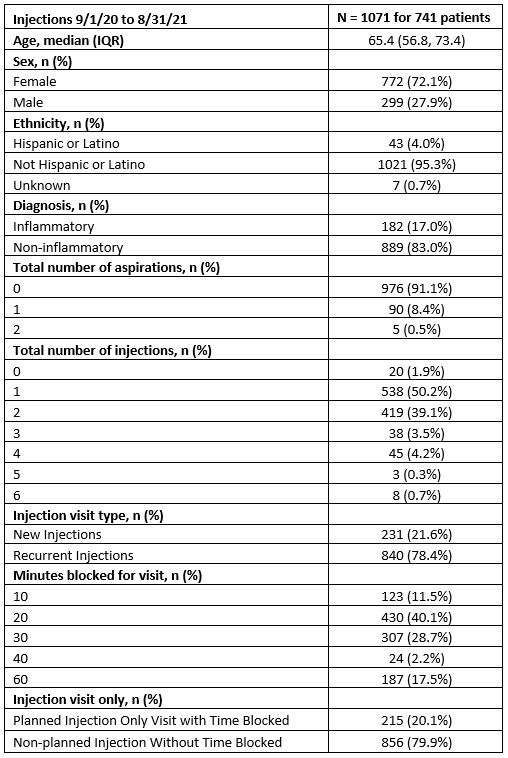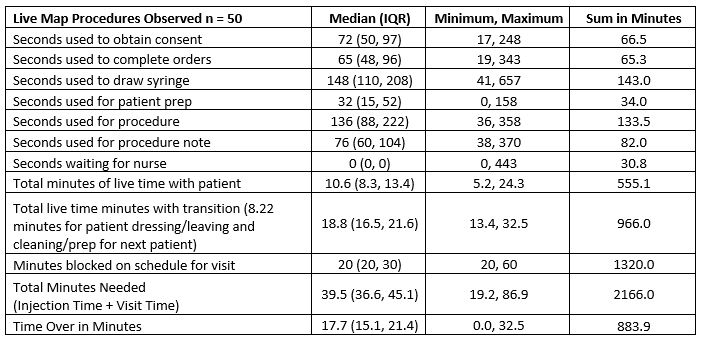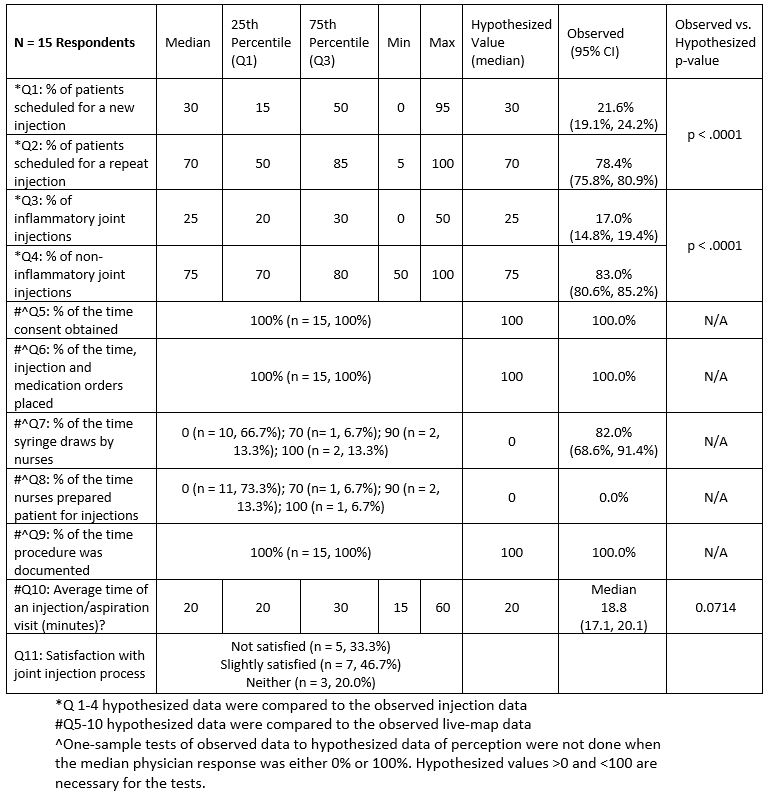Back
Poster Session C
Epidemiology, health policy and outcomes
Session: (1267–1303) Measures and Measurement of Healthcare Quality Poster
1285: Joint Injection Workflow in Rheumatology – an Opportunity to Improve Efficiency and Physician Satisfaction
Sunday, November 13, 2022
1:00 PM – 3:00 PM Eastern Time
Location: Virtual Poster Hall
- MB
Melissa Band, DO
Geisinger Medical Center
Danville, PA, United States
Abstract Poster Presenter(s)
Melissa Band1, Eric Newman2, Andrea Berger1, Kirsten Koons3, Madhuri Duggirala1, Rajesh Kuppuraju4, Peter Daniel Nicholas III5, David Bulbin6, David Pugliese7 and Jonida Cote8, 1Geisinger Medical Center, Danville, PA, 2Geisinger, Danville, PA, 3Geisinger Medical Center, Lewisburg, PA, 4Geisinger Medical Center, General Rheumatology Fellowship, Danville, PA, 5Geisinger Medical Center, Leesport, PA, 6Geisinger Health System, Danville, PA, 7Geisinger Health System, Wilkes-Barre, PA, 8Geisinger Medical Center, Orefield, PA
Background/Purpose: Physicians strive to provide patient-centered, timely care, often with perceived inadequate blocked time on the schedule. We aim to understand the joint injection workflow, its time allocation in the clinic, and physician satisfaction with the process in our academic rheumatology center.
Methods: An 11-question survey was used to gauge physicians' perception of the injection workflow and time allocation with 88% responses achieved. This was compared to observed live-mapping of 50 injections 9/7/2021-1/11/2022 and chart review of 1076 injections 9/1/2020 - 8/31/2021 extracted from the electronic health record. Patient demographics, disease and injection type, and time blocked for the procedure on the physician's schedule were obtained. Observed proportions from chart review were compared to hypothesized proportions based on median responses to questions 1-9 by 1-sample proportion-tests. The median procedure time from live observation was compared to the median value of physician perception in question 10 by Wilcoxon signed-rank test.
Results: Our population consisted of 72% women and 28% men, median age of 65 years old, mainly non-Hispanic, receiving recurrent injections for non-inflammatory joint disease. Only 20% of the procedures had scheduled injection time versus (vs) 80% who didn't per chart review (Table 1). Live-mapping data showed 8% of injections had scheduled time, while 92% were done as part of a standard clinic visit without blocked time, exceeding the scheduled clinic time by a median of 17.7 minutes (Table 2). Table 3 compares physician perception to observed chart review (questions 1-4) and live mapping (questions 5-10) patient injections. Physicians perceived doing 30% new/70% recurrent injections vs observed 21.6%/78.4% injections respectively (p< 0.0001). They perceived doing 25% inflammatory/75% non-inflammatory injections vs observed 17%/83% respectively (p< 0.0001). The perceived median time spent on an injection was 20 minutes vs observed median time 18.8 minutes (p=0.071). Physicians had 100% completion of consents/orders/documentation by both perception and observation. Nurses were perceived to assist with patient preparation 33% of the time and injection preparation 27% of the time but were observed to assist 100% and 82% of the time respectively. 80% of physicians reported low satisfaction with the process. We multiplied the number of unscheduled injections (856) by the median observed injection time (18.8 minutes) and divided it by physician full time equivalent (FTE 8.9) for this study resulting in an estimated 30 unblocked hours/clinical FTE/year over templated time as a result of unscheduled procedures at the current injection efficiency.
Conclusion: Time constraint is a common barrier to patient centered care and physician satisfaction. In our academic rheumatology center, the joint injection process took 17-19 minutes/injection. In addition, 80% of injections were done unscheduled resulting in an additional 30 clinical hours per physician per year over templated clinic time. 80% of physicians were not satisfied with the current injection process. Based on this data, we are redesigning the injection workflow to improve efficiency and physician experience.

Table 1: Observational Chart Review Data of Injection Procedures
 Table 2: Live Map Summary of Procedure Time in the Rheumatology Department
Table 2: Live Map Summary of Procedure Time in the Rheumatology Department
 Table 3: Physician Perception Versus Observed Patient Data of the Joint Injection Workflow Process
Table 3: Physician Perception Versus Observed Patient Data of the Joint Injection Workflow Process
Disclosures: M. Band, None; E. Newman, None; A. Berger, None; K. Koons, None; M. Duggirala, None; R. Kuppuraju, None; P. Nicholas III, None; D. Bulbin, AbbVie/Abbott, Novartis, Sanofi Genzyme, Alexion; D. Pugliese, None; J. Cote, None.
Background/Purpose: Physicians strive to provide patient-centered, timely care, often with perceived inadequate blocked time on the schedule. We aim to understand the joint injection workflow, its time allocation in the clinic, and physician satisfaction with the process in our academic rheumatology center.
Methods: An 11-question survey was used to gauge physicians' perception of the injection workflow and time allocation with 88% responses achieved. This was compared to observed live-mapping of 50 injections 9/7/2021-1/11/2022 and chart review of 1076 injections 9/1/2020 - 8/31/2021 extracted from the electronic health record. Patient demographics, disease and injection type, and time blocked for the procedure on the physician's schedule were obtained. Observed proportions from chart review were compared to hypothesized proportions based on median responses to questions 1-9 by 1-sample proportion-tests. The median procedure time from live observation was compared to the median value of physician perception in question 10 by Wilcoxon signed-rank test.
Results: Our population consisted of 72% women and 28% men, median age of 65 years old, mainly non-Hispanic, receiving recurrent injections for non-inflammatory joint disease. Only 20% of the procedures had scheduled injection time versus (vs) 80% who didn't per chart review (Table 1). Live-mapping data showed 8% of injections had scheduled time, while 92% were done as part of a standard clinic visit without blocked time, exceeding the scheduled clinic time by a median of 17.7 minutes (Table 2). Table 3 compares physician perception to observed chart review (questions 1-4) and live mapping (questions 5-10) patient injections. Physicians perceived doing 30% new/70% recurrent injections vs observed 21.6%/78.4% injections respectively (p< 0.0001). They perceived doing 25% inflammatory/75% non-inflammatory injections vs observed 17%/83% respectively (p< 0.0001). The perceived median time spent on an injection was 20 minutes vs observed median time 18.8 minutes (p=0.071). Physicians had 100% completion of consents/orders/documentation by both perception and observation. Nurses were perceived to assist with patient preparation 33% of the time and injection preparation 27% of the time but were observed to assist 100% and 82% of the time respectively. 80% of physicians reported low satisfaction with the process. We multiplied the number of unscheduled injections (856) by the median observed injection time (18.8 minutes) and divided it by physician full time equivalent (FTE 8.9) for this study resulting in an estimated 30 unblocked hours/clinical FTE/year over templated time as a result of unscheduled procedures at the current injection efficiency.
Conclusion: Time constraint is a common barrier to patient centered care and physician satisfaction. In our academic rheumatology center, the joint injection process took 17-19 minutes/injection. In addition, 80% of injections were done unscheduled resulting in an additional 30 clinical hours per physician per year over templated clinic time. 80% of physicians were not satisfied with the current injection process. Based on this data, we are redesigning the injection workflow to improve efficiency and physician experience.

Table 1: Observational Chart Review Data of Injection Procedures
 Table 2: Live Map Summary of Procedure Time in the Rheumatology Department
Table 2: Live Map Summary of Procedure Time in the Rheumatology Department Table 3: Physician Perception Versus Observed Patient Data of the Joint Injection Workflow Process
Table 3: Physician Perception Versus Observed Patient Data of the Joint Injection Workflow ProcessDisclosures: M. Band, None; E. Newman, None; A. Berger, None; K. Koons, None; M. Duggirala, None; R. Kuppuraju, None; P. Nicholas III, None; D. Bulbin, AbbVie/Abbott, Novartis, Sanofi Genzyme, Alexion; D. Pugliese, None; J. Cote, None.

